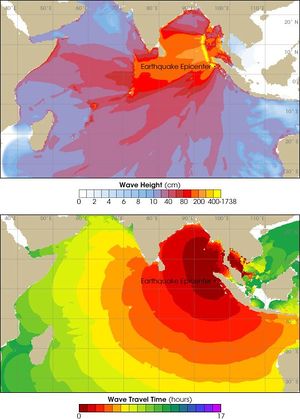Indian Ocean Tsunami
The Asian Tsunami hit the Indian coast in the early hours of Dec 26th 2004. Soon after the Tsunami, a group of people including IEEE members from Kerala Section left for Nagapattinam, the worst affected district in India. At Nagapattinam, after helping out in the rescue phase, this group set up an ICT based co-ordination centre. This was done using the mobile network and a central co-ordination Tent. In parallel, we created a web portal, using CMS software, to report on our activities.
Demand Based Relief – a paradigm change
One of the unique changes of operation that could be achieved through introduction of technology was a paradigm change in the way relief was handled. With the active application of the ICT, we organized a volunteer force to park themselves in the 72 affected villages / hamlets and transmit the requirements of the affected people in the villages using the cell-phone network. This demand was aggregated at the Government District Office over the Cell Phone Network.
We also started registering people and organizations, willing to give assistance. A desk was opened in the lawns of the District Office and also at the Disaster Web-site. We now had two lists: One of 'requirements' from the affected areas and the second; the possible areas of 'assistance' from the public and NGOs. By matching them, we could get optimize the aid delivery to the affected population, purely based upon their requirements.
This change in paradigm in relief effort has later been termed as a change from “Supply” based relief to “Demand” based relief. Till this point, effort, all humanitarian relief had been based on “Supply”, (ie) the donors decide on what the affected people require and supply these items, without any idea of what the situation on the ground is. In Nagapattinam, we had to dispose of tons of clothing as it was not required there and was causing sanitation and health problems. The introduction of Technology made it possible to bring in the new paradigm of “Demand Based” relief operation and was recognized as a unique application of simple technology.
Recognition
Our work was recognized by Government, who turned over all the Godowns under their control for distribution to the affected people based on demand. Besides the public, we also got recognition from various quarters, including, (a) A mention in IEEE Annual Report (2005), (b) A visit by Former US President Mr. Clinton to this unique “Public – Private Partnership” in Nagapattinam and (c) funding from UNDP, American Indian Foundation and various International NGOs. Apart from this, the best recognition came from the community, some of whom said, “if you want any assistance, tell it to the computer guys, you will get it”.
Rehabilitation Phase
At the end of the relief phase, our group was requested to form an “NGO Co-ordination and Resource Centre” (NCRC) at Nagapattinam to continue the activities into the rehabilitation phase. Here we got support from South Indian Federation of Fishermen's Federation, SNEHA and the UNDP. As there was no broadband connection in the coast, the NCRC established a WiFi network all along the 140 Km coastline of Nagapattinam District. This network was the basis of technology intervention into the 'rehabilitation' phase of operations.
Information on each individual affected by the Tsunami was entered into a database and the progress of rehabilitation for each individual was monitored so that, the relief reaches everyone. This project was successful in bringing Government Assistance to marginalised people and assure equity in rehabilitation.
Also see: IEEE Sri Lanka Section History
